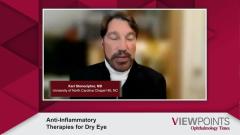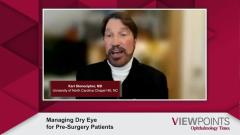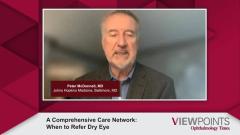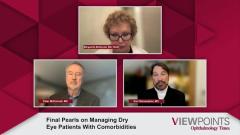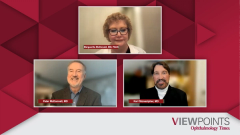
Dry Eye Evaluation in the Presence of Other Ocular Issues
Ophthalmologists provide insights into their diagnostic protocols for assessing dry eye.
Episodes in this series

Marguerite McDonald, MD, FACS: How do you describe your typical evaluation of patients? Like somebody marches through the door, say it's their annual exam, say they don't want cataract surgery or LASIK. How do you proceed, Karl?
Karl Stonecipher, MD: You look at the patient, you talk to the patient; basically what we're doing now is we're looking at a computer. Now some of us are fortunate to have scribes and some of us don't have scribes and maybe many times a scribe's not even in the room, but I think, [we need] to sit and talk to the patient before [we] delve into what [we] think the problem is, whether that's cataract, refractive, [etc.]. Whether you want to pick SPEED, we pick OSDI, we have them out in the waiting room. If a patient's waiting, they can fill that out and my staff are very, very cognizant of the fact that if a score is moderate to severe, we basically will say, “Hey, we're going to take a different path with you. You came in here for cataract surgery, but we're going to look at a lot of different things.” I enable my staff to do staining. I enable my staff to do tear breakup times. It's not huge scientific leaps for the staff to do a tear breakup time and say one Mississippi, two Mississippi, three Mississippi. And they put that all in my EMR. When I walk into the room, I think a lot of my patients already have been educated, whether that's through animations or whether that's through my staff saying, “Look, you've got a dry eye, we're going to talk to you about refractive cataract surgery.” This is what that means. We may have to have you come back, repeat a lot of the tests, but at the point in structure, we're still going to deal with your problem you came in for today. We're going to still deal with the fact that you have a cataract, but we may have to repeat some of these things. We put in a fluorescein stain, not fluoresce, we put in lissamine green. The fluorescein is for a tear breakup time. We don't want to use fluoresce because of the anesthetic. We put in lissamine green because that looks at the conjunctiva. And then last but not least we do an OSDI. And that, for me, is a way to tell a patient they got worse or they got better from a subjective standpoint too.
Marguerite McDonald, MD, FACS: I actually do something similar. Everybody gets the SPEED questionnaire. The patients appreciate [that] it only take some moments to fill it out. It shortens the conversation with me because I already know what their complaints are. And if they are contemplating surgery cataract or refractive, before I get in there, the techs have given the SPEED questionnaire and they have done topography and a tear osmolarity test. The topography you can see the breakup easily. And tear osmolarity gives me a tremendous amount of information. That's a very important part of my workup. Peter, any thoughts about that approach?
Peter McDonnell, MD: Yeah, I think [dry eye] is such a fascinating entity, because I believe it's not a disease. It’s a number of different conditions that create a constellation of signs and symptoms. And the signs and symptoms don't correlate very well. Some people are miserable, but their eyes don't look that bad. And some people have a lot of staining and deny many symptoms. It's one of those things where I think we need to be a little bit holistic. I've not found any single test. And when you look at clinical trials that the companies have performed to try to get their therapies approved, they are all so different. And there are these different populations of patients that exist, some with no staining, but lots of symptoms and vice versa. So I think that battery of tests that you all described is exactly right. And particularly we use lissamine green. Shirmer’s, when I trained was the thing; everybody got Shirmer’s test. Now I see less and less of that because it's not been as helpful in diagnosis and guiding therapy as we had hoped. So down the road hopefully we'll be able to segregate these patients and know based on certain tests what their likely response will be to different therapies, so we can target their individual problems a lot better. Maybe artificial intelligence will be using to guide us.
Karl Stonecipher, MD: You guys are pretty smart people and I feel like I know a lot about dry eye, but the artificial intelligence is picking up a lot of the co-conspirators for me. Like Marguerite was talking about earlier, whether that may be a medication that I didn't really know caused the dry eye. We're using a 50-questionnaire process that they go through. It deals with a lot of different things, like temperature, humidity, allergies, like you mentioned, Marguerite. And the dry patients can be a challenge in a clinic and so this is something they can do before they come in. It finds a way into our EMR, so it's not like I have to repeat or transcribe or do something completely different. For me, it's mainly on the diagnostic side right now. We have about 30,000-plus assessments and we really won't get into deep learning until we get into about 250,000, but I think it's pretty amazing; things like lid wiper epitheliopathy that we may put in there. Maybe it's something like lagophthalmos, like you talked about, or blink rakes that you guys talked about earlier, or, it can be a laxity of the lids. There's all sorts of things that we just on a day to day don't think about in our patient population.
Marguerite McDonald, MD, FACS: A couple of minutes ago, Karl, you mentioned that early in the exam, when you find evidence of ocular surface disease, that you sort of halt everything. I do that too. I'll go in, meet and greet, examine them at the slit lamp, do my stains, and I'll say, “I know you're here for cataract surgery, but we've determined that you have dry eye. We're going to treat it for a few weeks and bring you back, and we'll finish the exam, and it'll be more accurate, your pre-op measurements, you'll sail through the surgery, your post-op recovery will be better.” And I've never lost a patient with that approach. Have you, Peter? Have you, Karl?
Peter McDonnell, MD: I think they really appreciate that approach. I think what it says, many patients say, is that “this is a doctor not trying to turn me into a surgical patient, but a doctor that really wants to take care of me.” I consider it to be quite a practice builder actually, and no, I've never had a patient react negatively to that.
Transcript is AI-generated and edited for clarity and readability.
Newsletter
Don’t miss out—get Ophthalmology Times updates on the latest clinical advancements and expert interviews, straight to your inbox.



